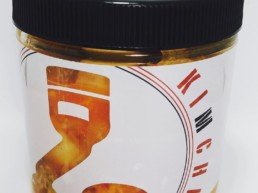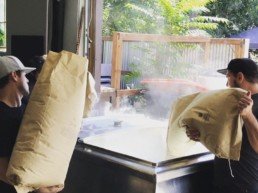Our Approach Uses Yeast & Bacteria
Hops. Barley. Malt. These are terms well-known in tasting notes of craft beers. But those ingredients only account for a small portion of the flavors people love — the other ingredients are what we like to call “Good Bugs.” These are the yeast and bacteria strains that catalyze the fermentation process. Where hops and malts are the jocks in the school of brewing, Good Bugs are the talented nerds. They’re the ones who grow up to be something really special. We lead with this ideal when we collaborate with innovative brewers across the country to create “nerdy” and flavor forward brews.
That’s why we think these Good Bugs deserve more credit. And not just in beer. Their dynamic flavor expressions turn both beer and food into an elevated realm. It’s our hope to one day read and hear beer (and food) tasting notes that include these “Good Bugs”, giving them proper kudos.
Our Good Bug Fermentation Series takes our philosophy about fermented food and pairs it with our favorite breweries. The expertise of these brewers expand and extrapolate the possibilities of our Good Bugs, and we wouldn’t be able to create such dynamic flavor profiles without their help. Check out specs on our beers down below.
Collab Brews
Microorganism Fermentation= More Flavor
- During fermentation, yeast consume sugars and primarily produce Ethanol, CO2 and Cell Mass.
- An ester is a volatile compound formed from an organic acid and an alcohol which is responsible for the fruity aromas and flavors in beer.
- A Phenol or Phenolic Compound is a hydroxylated aromatic carbon ring responsible for smoky and spicy flavors in beer.
Meet the Microorganisms
So if we are pushing hops and malts out of the spotlight, what ingredients are taking their place? They might be smaller in size, but they are bigger in taste.
Our co-conspirators at Denver’s Inland Island Yeast Laboratories are hard at work, bringing the highest cell counts, most viable and consistent strains and blends to our experiments. These efforts build towards the development of strains specifically designed to be used by both brewers and chefs as part of the Brewed Food and Good Bugs movements.
Brettanomyces Claussenii
Originally isolated from strong English stock beer in the early 20th century, this exciting microorganism is a wild yeast that has a negative Pasteur effect. It and Brettanomyces Anomalus share identical mtDNA. They are extremely virulent “eaters” — they will consume complex sugars many other yeasts will not and they consume slowly and for extended periods of time. In the wild, it is found on the skins of fruit. It produces a fruity, unripe passion fruit or pineapple rind aroma.


Lactobacillus Brevis
A gram-positive, rod shaped species of lactic acid bacteria is heterofermentative, creating CO2 and lactic acid during fermentation. There are approximately 16 different Brevis strains known. It can be found in many different environments, usually thriving at warmer than normal temperatures for lactobacillus, around 115F. It has a distinct flavor characteristic of lemon, lemon peel or meyer lemon.
French Saison
This formerly wild harvested strain from Franco regions of Belgium ferments at higher temps around 29 to 35 °C (84 to 95 °F). They generally form a foam on the surface of the fermenting beer, which is called barm, as during the fermentation process its hydrophobic surface causes the flocs to adhere to CO2 and rise. Because of this, they are often referred to as “top-cropping” or “top-fermenting”. Its flavor expression can range from white pepper to black peppercorns and finishes very dry.

Free Beer & Good Bugs News
All our new subscribers will be automatically entered to win a 4 pack of exclusive Good Bugs collaboration beers!
HELP SPREAD THE WORD, SHARE ON SOCIAL!




























